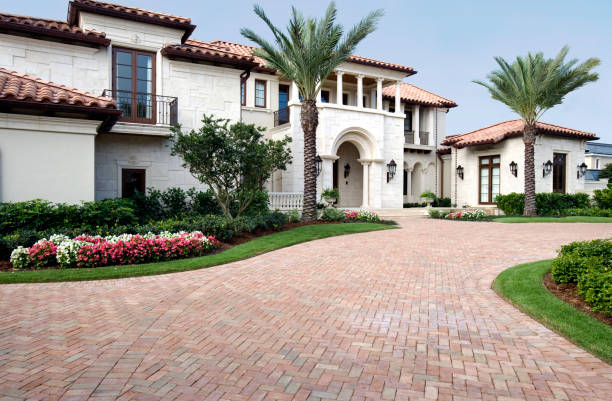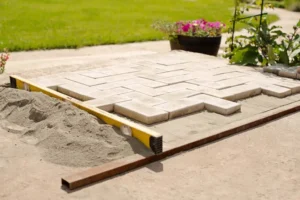Tired of looking at your cracked, worn-out driveway? A paver driveway can completely transform your home’s curb appeal and increase its value. Wondering how to install a paver driveway? While it might seem daunting, with the right tools and steps, you can create a beautiful, long-lasting driveway with ease.
A well-installed paver driveway can last up to 30 years, offering both beauty and practicality. Don’t worry, we’ll guide you through every step—from planning and prepping the area to laying the pavers and finishing with those perfect details. With a little effort, you’ll have a driveway that not only enhances your home’s appearance but also endures the test of time. Ready to upgrade your driveway? Let’s get started!

Why Choose a Paver Driveway for Your Bay Area Home?
A Bay Area paver installation driveway offers numerous advantages over traditional concrete or asphalt surfaces, making it a smart investment for homeowners looking to enhance curb appeal, durability, and long-term value. Here’s why paver driveways are an excellent choice:
1. Superior Durability and Strength
Paving stones are specifically engineered to handle heavy loads and frequent traffic without cracking or deteriorating over time. Unlike concrete, which is prone to cracking due to temperature fluctuations, or asphalt, which can soften in high heat, paver driveways remain strong and intact. Their interlocking design also distributes weight more effectively, reducing wear and tear.
2. Enhanced Aesthetic Appeal and Customization
One of the biggest advantages of paver driveways is their versatility in design. Available in a wide range of styles, colors, shapes, and patterns, they allow homeowners to create a truly unique look that complements their home’s architectural style. Whether you prefer a classic, modern, or rustic appearance, pavers provide endless customization options. You can also incorporate borders, contrasting patterns, or even a mix of different stone types to enhance visual appeal.
3. Low Maintenance and Easy Repairs
Unlike concrete and asphalt driveways, which can be difficult and costly to repair, paver driveways offer an easy maintenance solution. If a paver becomes stained, cracked, or damaged, it can be removed and replaced individually without disturbing the entire surface. This feature not only saves time and money but also ensures that your driveway maintains its pristine appearance for years. Regular sweeping, occasional pressure washing, and reapplying joint sand as needed will keep your paver driveway looking fresh and well-maintained.
4. Better Drainage and Eco-Friendly Benefits
Paver driveways promote better drainage compared to solid concrete or asphalt surfaces. Water can seep through the joints between pavers, reducing runoff and helping to prevent puddles, erosion, and water damage. Permeable paver options are also available, allowing rainwater to filter back into the ground, supporting eco-friendly landscaping solutions and minimizing strain on stormwater systems.
5. Increased Property Value
A professionally installed paver driveway not only boosts your home’s curb appeal but also adds to its overall market value. The combination of beauty, durability, and low maintenance makes paver driveways an attractive feature for potential buyers, providing an excellent return on investment.
Understanding the Costs of Paver Installation
Now that you’ve picked your materials and secured the necessary permits, let’s dive into the cost breakdown of how to install a paver driveway! Driveway paver installation typically ranges from $10 to $70 per square foot, with an average-sized driveway costing between $4,800 and $19,200.
But don’t let that range throw you off! The final price depends on several key factors, like the size of your driveway, the type of pavers you choose, and any complexities of the installation site. Additional considerations, such as drainage systems or labor costs, can also influence your budget.
Here’s the silver lining: Driveway paver installation is an investment that pays off. While the upfront cost may seem daunting, pavers require less stormwater management and lower maintenance over time. They’re durable, easy to clean, and can actually enhance your property’s value—plus, you could even save on water bills or stormwater fees down the road.
Step-by-Step Guide How to Install a Paver Driveway
1. Plan and Design Your Driveway
Start by measuring the area where you’ll lay your driveway pavers. Sketch a detailed plan, including dimensions and the desired pattern. Don’t forget to account for water drainage and slopes to prevent pooling.
2. Excavate the Area
Clear the area of grass, soil, and debris to a depth of about 12 inches. This depth allows for the base, bedding sand, and the pavers themselves. Use string and stakes to mark the boundaries of your driveway.
3. Lay the Base
Spread a 6-8 inch layer of gravel evenly across the excavated area. Use the plate compactor to tamp it down firmly. This base provides stability and prevents shifting over time.
4. Add a Layer of Sand
Next, spread a 1-inch layer of coarse sand over the compacted gravel. Use a level to ensure the surface is even. This layer acts as the bedding for your pavers.
5. Install Edging Materials
Secure the edges of your driveway with edging materials to keep the pavers in place. These can be plastic, metal, or concrete depending on your design.
6. Lay the Paving Stones
Start laying driveway pavers from one corner, working your way outward. Fit them snugly together according to your design. Use a rubber mallet to gently tap each paver into place.
7. Fill the Joints
Once all the pavers are laid, sweep sand into the joints to lock them together. Polymeric sand is a great choice as it hardens when wet, creating a durable seal.
8. Compact the Surface
Use the plate compactor again to ensure the pavers are securely set. This also helps the sand settle into the joints.
Tips and Tricks for Success
Choose High-Quality Pavers: Don’t settle for less when it comes to materials! Investing in durable, high-quality pavers ensures your driveway can handle heavy traffic, harsh weather, and everything in between. It’s a small upgrade now that will save you big down the road.
Work with a Partner: Two heads are better than one! Having an extra pair of hands can make all the difference, especially when tackling tasks like compacting. Team up to get the job done faster and more efficiently.
Check Levels Frequently: Keep things smooth and functional! An uneven driveway can lead to drainage problems, so don’t skip the step of checking your levels often. A little extra time spent here can save you a lot of headaches later.
Plan for Future Maintenance: Stay ahead of the game by keeping extra pavers on hand. It’s much easier to replace a damaged paver right away than to deal with bigger repairs down the line. A little prep now can keep your driveway looking perfect for years to come.
Common Mistakes to Avoid When Installing a Paver Driveway
A well-installed paver driveway can enhance your home’s curb appeal and last for decades. However, certain installation mistakes can lead to costly repairs and maintenance issues. To ensure a long-lasting and durable driveway, it’s important to understand the process of driveway paver installation correctly. Avoid these common pitfalls:
1. Skipping Proper Base Preparation
One of the most crucial steps in paver driveway installation is preparing a strong and stable base. Many DIYers make the mistake of laying pavers directly onto soil or an inadequately compacted base, leading to shifting, sinking, and uneven surfaces over time.
Why It’s Important:
- A poorly prepared base can cause pavers to settle unevenly, creating trip hazards.
- Shifting and sinking due to weak support can lead to cracks and misalignment.
- A solid foundation ensures long-term durability and prevents weed growth between the pavers.
How to Avoid This Mistake:
- Excavate properly: Dig out at least 6–12 inches below the finished surface level, depending on soil conditions and expected traffic.
- Use the right materials: A well-compacted base of crushed stone or road base gravel is essential. Avoid using soft or ungraded fill materials.
- Compact in layers: Instead of filling the entire depth at once, compact the base material in 2–3 inch layers using a plate compactor to achieve maximum density.
2. Improper Sand Layering
The layer of sand beneath your pavers, often referred to as the bedding layer, plays a critical role in ensuring the stability and interlock of your driveway. Mistakes in this step can cause the pavers to shift or become uneven.
Common Sand Layer Mistakes:
- Using too much or too little sand, leading to weak interlocking.
- Failing to level the sand properly before laying the pavers.
- Using the wrong type of sand—coarse, angular sand (like concrete or polymeric sand) is preferred over fine or beach sand.
How to Get It Right:
- Use a proper bedding layer: Spread 1 inch of coarse, sharp sand (such as concrete sand) evenly over the compacted base.
- Screed the sand evenly: Use a long, straight board or screed tool to level the sand, ensuring uniform thickness.
- Avoid walking on the sand layer: Once leveled, avoid disturbing the sand before placing the pavers to maintain an even surface.
3. Ignoring Proper Drainage
Water management is essential for preventing damage to your paver driveway. If drainage is not accounted for during installation, you may experience pooling, erosion, or water seeping beneath the pavers, leading to instability and potential base failure.
Why Drainage Matters:
- Standing water can weaken the base and lead to shifting or sinking pavers.
- Poor drainage contributes to weed growth, mold, and mildew buildup.
- In colder climates, trapped water can freeze and expand, causing pavers to crack or heave.
How to Ensure Proper Drainage:
- Grade the surface correctly: Your driveway should have a slight slope (about 1/8 inch per foot) to direct water away from your home and foundation.
- Install a drainage system if needed: In areas with heavy rainfall or poor soil drainage, consider adding a French drain or installing permeable pavers to allow water to drain naturally.
- Use proper joint sand: Polymeric sand helps lock pavers in place while allowing water to pass through, preventing washout and erosion.

Get Professional Results with Lakota Design Group
Avoiding these common mistakes is the key to a long-lasting, beautiful paver driveway! If you’re wondering how to install a paver driveway the right way—without the hassle—Lakota Design Group has got you covered. With years of expertise in Bay Area landscape design and hardscaping, we take the stress out of the process. We’ll make sure your driveway is built to last, with attention to every detail, from proper base preparation and precise sand layering to top-notch drainage solutions. Let us help you create a driveway that stands the test of time and looks stunning every day!
Final Thoughts
Learning how to install a paver driveway doesn’t have to be intimidating. By following these steps and avoiding common mistakes, you can create a beautiful and durable driveway that enhances your home’s curb appeal. Whether you’re tackling the project solo or enlisting help, the key is thorough planning and patience. A paving stone driveway installation requires careful attention to detail and the right tools to ensure long-lasting results.If you want expert results without the hassle, choose Lakota Design Group for professional paver driveway installation. Our team ensures precision, durability, and a stunning finish that elevates your outdoor space. Ready to start your paving stone driveway installation? Grab your tools, or let us handle the hard work for you!
FAQS
What are the benefits of installing a paver driveway?
A paver driveway offers durability, aesthetic appeal, and easy maintenance. It’s resistant to cracking, customizable in design, and individual pavers can be replaced if damaged.
What tools and materials do I need for driveway paver installation?
You’ll need paving stones, gravel, sand, edging materials, a plate compactor, shovel, wheelbarrow, level, measuring tape, rubber mallet, broom, and string with stakes.
What is the first step in installing a paver driveway?
Start by planning and designing your driveway. Measure the area, sketch a layout, and account for water drainage and slopes to avoid pooling.
How deep should I excavate the area before laying the base?
Excavate the area to a depth of about 12 inches to allow for the base, bedding sand, and pavers.





